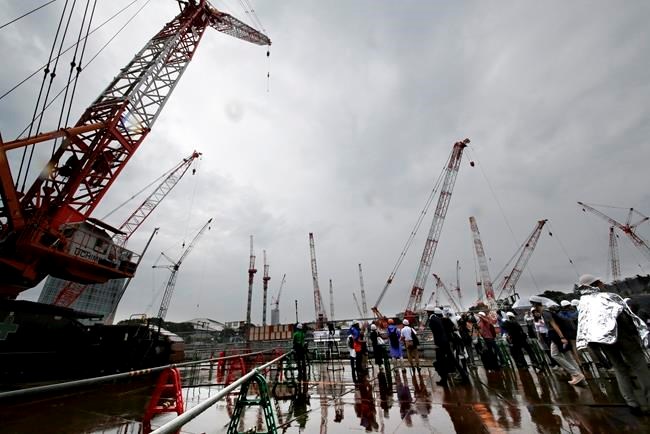TOKYO — The Olympic stadium in Tokyo is taking shape with 22 cranes on site and the spectator stands being installed after 10 months of underground foundation work.
With its completion deadline just over two years away, work is intense.
Olympic Minister Shunichi Suzuki, during a visit to the New National Stadium on Tuesday, said the construction is proceeding as scheduled, praising the workflow efficiency. He said all possible technology must be mobilized to finish the stadium by the November 2019 deadline. Suzuki, however, cautioned that workers should not stockpile overtime.
"Working conditions must meet legal standards," Suzuki said.
Suzuki cited the suicide this year of a worker linked to overwork, or "karoshi," and addressed the concerns about the working environment at the project. He reminded main construction company Taisei Corp. and the Japan Sport Council, the government-funded stadium operator, to keep close tabs on overwork. The operators have since taken measures and the working environment has improved.
The construction was more than a year behind schedule when it started, as an earlier stadium plan was scrapped because of a spiraling cost and unpopular design. The government approved the 150 billion yen ($1.5 billion) stadium by a joint venture among Taisei, Azusa Sekkei Co. and the office of Kengo Kuma, an architect who designed the replacement.
In order to save time, Taisei and its subcontractors are bringing in precast and semi-assembled components from factories for quick installation.
The site has about 1,000 workers on an average day, said Yukio Komatsu, an on-site planning and management official at JSC. As many as 3,000 people will be needed per day later when the roof, exterior, and interior will be simultaneously worked on. Komatsu said the workforce is expected to be secured until the end of the project.
Japan has faced a shortage of construction workers following the March 2011 earthquake and tsunami as the region continues to rebuild. Construction rush for Olympic venues and related facilities add to the crunch and workload, making construction workers increasingly vulnerable to overwork, experts say.
The construction sector is excluded from the government's planned tightening of overtime limits for the time being. Last year, construction was one of most karoshi-prone sectors in Japan, with 16 victims acknowledged by the government.
The death of the 23-year-old worker captured national attention in July when his family sought the government to certify him as a karoshi victim. The body of the man was found in the central Japan mountains in April, weeks after he disappeared, with a suicide note saying he was "physically and mentally pushed to the limit." His lawyer said his overtime exceeded 200 hours a month before he killed himself — more than twice the 80-hour-per-month redline for a death from overwork.
Tokyo's
The stadium delay was part of Japan's troubled preparations for the Olympics, underscoring a widespread lack of cost-control. Officials are bracing for a possible delay in the construction of roads linking the main Olympic venues near a new fish market project, which has been hit by a construction scandal and tainted underground water.
___
Follow Mari Yamaguchi on Twitter at https://www.twitter.com/mariyamaguchi
Find her work on APNews at https://www.apnews.com/search/mari%20yamaguchi
Mari Yamaguchi, The Associated Press

